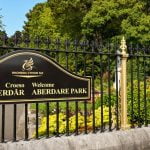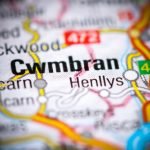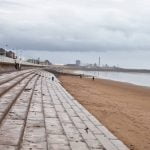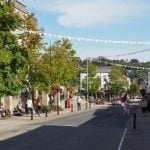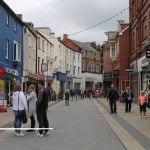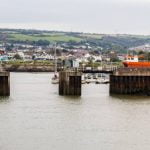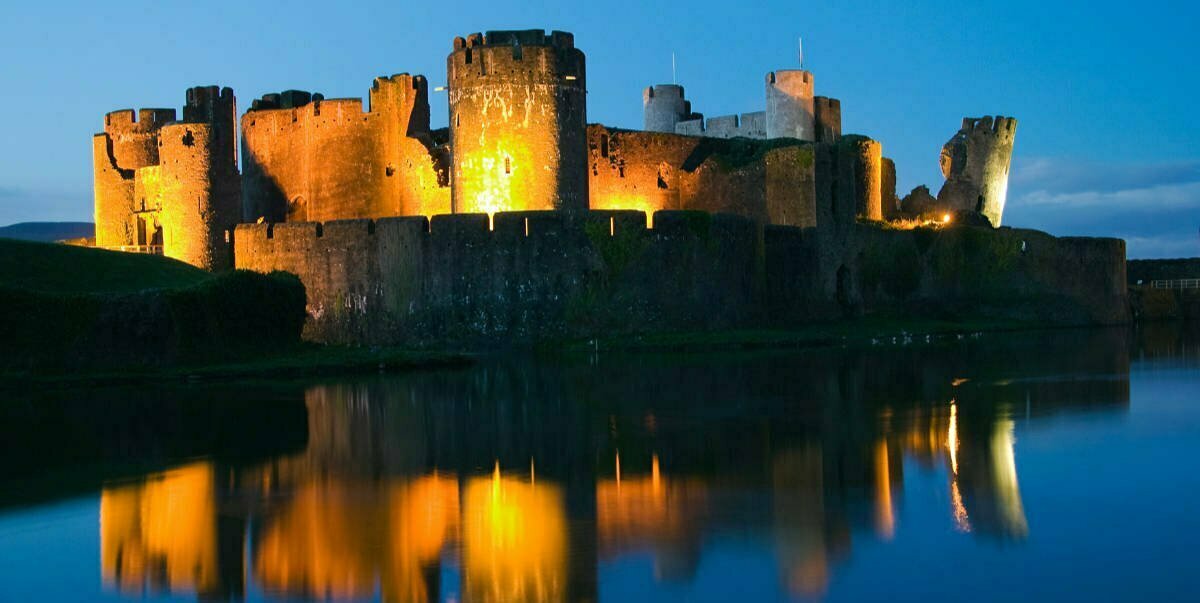
Caerphilly (or Caerffili to give it its Welsh name) is the ideal base to explore the Rhymney Valley!
Here at Five Minutes Spare, we are always on the lookout for ways to improve local tourism. What better way could there be than by lovingly creating travel guides to encourage exploring the UK? Caerphilly is now in Gwent but once formed part of both Glamorgan & Monmouthshire and like the rest of Wales was a tribal area until the Romans arrived. Even then, the tribes and the old kingdoms of Wales held on which gives the country its incredibly rich history.
Anyway, the great bits include Caerphilly having its own castle, its only 11km from Cardiff, and sits in a valley filled with some gorgeous countryside. If that’s not enough to entice you to visit then keep reading. We’re about to explore this beautiful town through words but we encourage you to do it with your eyes and feet. So without further ado, let’s get started. With a little bit of that history because everyone likes a bit of history…
The Early History of Caerphilly
In old Welsh, a Caer is a fort. The town gets its name from being a fort placed at Ffili. Historians don’t know whether the Ffili is the St Cenydd’s son, or if the fort belonged to a lord Ffili, to begin with, and a town grew up around its shelter. There is speculation that the Roman association with the word Caer formed the town’s name. Either way, we know there was a Roman fort here and that the Romans occupied it until the 2nd century. After this, troubles back home forced them to abandon their eastern boundary and head back to Italy. The Romans record the fort as erected in 75AD and standing for two hundred years or so.
The Roman fort stands about a hundred yards from the castle, so it appears as though the castle was here for similar reasons. The town has strategic importance in accessing the surrounding lands. This has made it prime territory over the years when it comes to military takeovers.
Let’s talk about before the Romans got here. Historical evidence suggests that this was the home of the Silures tribe. They occupied a great portion of southeastern Wales. They had an army of 5,500 soldiers strong, a marvel in those times. They raised an unprecedented army against the Romans, with the help of other non-Roman Europeans. The Silures were a warlike people who hated the Romans and joined the Trinovantes to strike back at the occupying forces. The Silures faced Sextus Julius Frontinus in 73AD and went on to cause trouble while the Romans were here. The Welsh have been resisting occupiers since before Wales was Wales.
Where to go to learn about Family History?
If you think you have roots in this ancient Welsh town, the local council might help you out with census information. You might also seek help with Caerphilly Local History Society, which began in 1957 and is still running today.
The Medieval Era in Caerffili
Moving on to the Medieval period. To begin with, the Romans never fully conquered Wales. The area around Senghenhydd remained in Welsh hands, so there were parts of this region that were Welsh right up until the 1200s. They survived the Norman invasion, too. In 1066, your boy William got as far as the Welsh borders and thought twice about crossing them.
The town’s growth started with the castle, completed by the Norman Lord Gilbert de Clare in 1268. He built the castle to look ferocious, to help maintain control over the conquered lands. After this things get murky. Gruffydd ap Llewelyn – the self-proclaimed Prince of Wales, tried to conquer the castle in 1270 and some say successfully razed it to the ground. Other reports say he was unsuccessful.
He struck before the builders could complete the defences. The townsfolk rebuilt the castle in 1271, and then in 1316 the town suffered horrible destruction during another battle – but the castle stood firm. Llewelyn Bren attacked with 10,000 men but did not win. The Prince of Wales went on to cause havoc all the way across the English border. He might not have won the castle, but he gave winning the war a dang good shot.
In 1326 the castle underwent remodelling for Hugh le Despenser. The following year Queen Isabella besieged it. By 1536, history records that the castle stood empty and derelict. One part remained as a gaol. In the English Civil War, the Parliamentarians destroyed even the working part. One of the towers reportedly stands squint to this day thanks to an unsuccessful attempt to blow it up.
The town of Caerphilly made the history books once more during the Medieval period and that was all the way through the 1700s. In 1742, the first ever Methodist Chapel appeared in Gross Wen, courtesy of the mother church. By then, Caerphilly was a market town on the edge of a valley that grew exponentially thanks to industrialisation. Although the town was never industrially poisoned, you could never deny the mining and smelting history.
Fun Facts about Caerphilly
As we research the history of any town we are touring, we always come across strange and interesting facts. We noticed this so often that we added this section as standard to all touring articles. This is where we put the fun things you can talk about to entertain people at parties. Have at it.
- Caerphilly is famous for two things: the castle and the cheese. Caerphilly cheese is just as legendary as the myths surrounding the town. Make sure you try it when you visit.
- Plot twist – there’s only one producer of Caerphilly cheese in southern Wales. Cheesemakers produce the rest in Lancashire, Shropshire, or Cheshire.
- Caerphilly castle is only smaller than Windsor Castle, making it the second largest in the UK. There are thousands of castles in the UK. The UK still includes Scotland.
- Local reporters speculate on the existence of ‘the Green Lady.’ Every castle has to have a lady of some multi-colourful description haunting its windows and gazing forlornly out to sea. This one is green.
- Tommy Cooper was born here and they erected a statue to him so nobody ever forgets it.
- Caerphilly has a tradition of film set facilitation. It featured in a Dr Who episode and in a documentary about the Sex Pistols. What more could you ask for?
Caerphilly has interesting locations and interesting people. Let’s prove it further with additional information about the town’s history.
The Industrial Period
During the Industrial Era, the town began to slowly grow. Previously, its growth depended on the castle. Now it took off on its own. The castle became a tourist attraction and drew in tourism just at a time when the railway arrived, making tourism possible for outlying towns just like Caerphilly. In 1801, the population was only 4,162 people. Despite the size of the fortress, the town was small. In the 1830s the first Caerphilly Cheese appeared, with production not stopping since. In 1863 a colliery opened called Rhos Llantwit. To this day, the national mining monument is a town feature. You can find it at Senghenydd.
In 1887, the town got its own rugby team. Rhos Landwit closed in 1892 after the coal reserve ran out. Today, the colliery lies under the Llandsbury Park housing estate. The railway did not reach Caerphilly until 1899, about fifty years after the first few tracks opened in London.
By 1905 the town needed a golf club so local man Charles Stuart Goodfellow laid out a 9-hole course on the side of the local mountain. In 1910 the local cheese market closed, although they still made cheese here. By 1911, the town’s population was 32,844 people – so the cheese had performed its task of attracting growth. The first boy’s school opened in 1912 and then in 1921, Tommy Cooper was born.
Modern Day Caerffili
In 1925, the Great Western Garden Village society opened with the aim of giving housing to railway workers. The cheese production here stopped once: during WWII when many young men from the town fought and died for their country. In 1950, the town had its first National Eisteddfod festival here. Ten years later the town twinned with Ludwigsburg in Germany. By 1961 the population was 35,997, but then in 1971, it was 40,778 people.
Caerphilly made international headlines in 1976 when the Sex Pistols gave a concert there. The local churches were outraged and protested outside the Castle Cinema. This idyllic incident caused the town to feature in their documentary many years later. Archaeologists uncovered Roman artefacts in 1963 which showed the fort remained occupied by the Romans until the 2nd century. In 1994 the town twinned with Pisek in the Czech Republic.
As of 2001, the whole district and urban area of Caerphilly is home to 169,521 people. That’s a heck of a lot of people to flock to the shelter of a defunct castle. It’s a lovely place which has thrived through tourism and industry. There are retail establishments all over the city, where the large castle acts to draw them in. Spending a few days here is a great way to explore and make fun family memories. Just watch out for that squinty tower. One day it’s sure to fall.
Famous People from Caerphilly
Want to know who you might meet in Caerphilly? In this section, you will find out who the famous people from the town are. Hang around the local pub long enough and you might spot one. Hopefully, one that is still alive.
Famous people from Caerffili include:
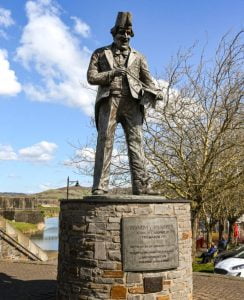
Arguably Caerphilly’s most famous son.
Image: Ceri Breeze/Shutterstock.com
- Tommy Cooper – the amazing comedian and magician came from Caerphilly
- Arsenal player Aaron Ramsey was born here, as is Wales football player Robert Earnshaw after his family emigrated.
- TV Presenter Matt Johnson, who has presented the lottery in the past.
- Welsh painter Phil Nicol is from here, as is artist Peter Prendergast.
- Actress Leona Vaughan was born here
- And a bunch of MPs
Let’s get back to the good stuff before we lower the tone with politics. Here are the fun things you should see and do in town if you are staying for a few days.
Attractions in Caerphilly
Heading to South Wales for the summer, autumn, winter, or spring break? Here are all the things you should see and do when you get there.
Historic Sites and Landmarks
The most obvious important landmark in Caerphilly is Caerphilly castle. Built back in the 1200s and still standing today, this epic castle is the largest in Wales. It’s so big that even though it fell into disrepair in the 1500s, it’s still standing to this day. The castle’s owners reportedly extended it over time to keep out the legendary Prince of Wales. The man and the myth, as well as the castle, are all legendary in popular culture. Have a wander around the castle and make sure to take pictures of that squinted tower where the Parliamentarians tried (and failed) to blow it up.
A second popular historic house in the area is Llancaiach Fawr… we hope we are spelling these correctly. Legend says this manor house is so haunted that they run regular ghost tours. The house dates back to 1645 and the interior is a perfect replica of life during that time. The attraction is popular among kids and schools because it is educational and inspirational. They have a lovely garden with a maze and a brilliant tea shop that offers afternoon teas you won’t believe.
Galleries and Museums
When visiting the area, it’s a good idea to get to know it better. This region of Wales only grew to its current population levels because it was the home of mining in the southwest of the UK. This was a fertile coal country, where miners lived and worked and died from black lung. The families that grace the poorer areas of the city are those whose parents were miners and whose grandparents smelted iron and steel.
They are the remnants of a people who worked back-breaking hours in long shifts to haul coal for their masters. They are hardy and proud, and you should find out more about them at the local museum. Head to the Aber Valley Heritage Museum to learn about the trials and tribulations of the coal miners who lived and died in Caerphilly.
While you are in the vicinity, go to the Windsor Colliery and see the site where a mining shaft once operated. The whole area is remarkable for its mining heritage. Be sure to stop at the national mining monument and pay your respects, too. You should still be able to spot the tracks that carried the coal, and perhaps some of the machinery they used to draw it up out of the ground.
If you want art but not the trek to the National Museum in Cardiff, the Y Galeri Caerffili is your next best bet. Situated in Caerphilly town, this studio features work by contemporary Welsh artists still earning their names. This gallery runs regular exhibits that change throughout the year. Catch a show or buy some fine art, all within Caerphilly itself.
Outdoor Attractions
To the southwest of the coalfields outside of Caerphilly, you will find Caerphilly Mountain. Standing between the town and Cardiff, this mountain peaks at 271 metres above sea level… which isn’t that much when we compare it to Snowdonia. However, Caerphilly Mountain is perfect for hiking and biking. There is an 8 and a 10km loop walk. The latter of which takes about 3 hours to complete. If you’re fit and you love good views, this hill lets you see the entirety of Cardiff on a clear day. Sorry. Mountain. It’s a mountain. Honest guv.’
There is a fantastic park in Caerphilly which locals deliberately crafted over the top of one of the old coal fields. You can go and wander around this area, where artists and sculptors carved giant animals into the landscape. The horse is particularly stunning, although you can see it best from above.
Parc Penalta was a coal tip up until 1990, after which artists got creative in the space. The horse is known as Sultan the Pit Pony, a tribute to the many horses that pulled coal for us, that we have forgotten about. You can visit a viewpoint in the park to get a good look at him, or you can use it for sunbathing. The park has a little pond too, though we don’t recommend swimming in it. There is an observatory area and benches to sit and enjoy the views.
If you don’t want to climb anything, take a gentle stroll through Sirhowy Valley Country Park instead. This gentle ambling countryside is situated on the old railway lines. In fact, the whole park was the home of former transport links. There used to be a railway track that ran from the Newport docks in the south up to Tredegar in the north. The national cycle network also runs through here. You can follow the banks of the River Sirhowy or you can enjoy the gardens and lawns.
Tommy Cooper Walk
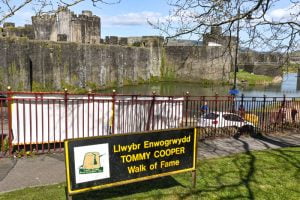
Image: Ceri Breeze/Shutterstock.com
Finally, you must do the Tommy Cooper Walk of Fame which runs from Caerphilly Visitor Centre to the statue at the top of the Twyn car park. Wearing a Fez while muttering “just like that” is optional but sure adds to the fun!
Sports and Recreation
Caerphilly has a rugby team named Caerphilly RFC. In this neck of the woods, rugby was more popular than football and sometimes still is. The RFC here began in 1887 and is still going strong today. You can visit them at the Molex Stadium in Virginia Park. Visit to see them play or to take part in some of the amateur clubs.
Caerphilly took a few hundred years but it did finally get its own football team. Founded in 2008, you can find Caerphilly Athletic FC playing in the South Wales Alliance Division 1… which is pretty good innings for such a new club. The locals nicknamed them the A’s.
As for golf, Caerphilly has it all. You can play at that 9-hole Caerphilly Golf Club set up all the way back when. If that’s not to your liking, head to the Castle Heights Golf Club for a course with a view. Still not sparking your interest? The Ridgeway Golf Club is just south of town.
Shopping and Retail
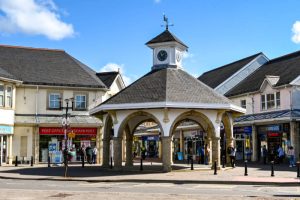
Image: Ceri Breeze/Shutterstock.com
Caerphilly is the town for the small business. There are still plenty of shops to see in and around the town centre. The situation of the castle has brought touristy businesses here, so there are lots of small stores. If you want good designer shopping, head out to the Castle Court Shopping Centre. There’s also the Castle View shopping centre if you fancy a change of scenery and less expensive stores.
Other Notable Caerphilly Attractions?
If you are staying in town for longer than just a day or two, here are some other sights and sounds you should consider enjoying:
- Visit the fantastic statue at the National Mining Monument in town.
- Have a cup of Joe at Coffi Vista, one of the town’s best coffee shops.
- Visit St Martin’s Church for a service or to see pretty architecture.
- Browse around the Senghenydd memorial garden while you visit the national mining memorial.
- Visit the Bedwas Workmen’s Hall to attend an event or dance.
- Take the kids to Poppelwood and enjoy the entertainment.
- Learn about taxidermy at the Morbitorium… not for the faint of heart.
How to Get to Caerphilly?
Now you know everything about this town that we do – probably more if you live there. If you don’t live there, then you will need these thoughtfully accurate directions to help you get there.
By Road
Head to Cardiff on the M4 then swing north along the A470.
By Rail
You are looking for Caerphilly Train Station.
By Air
Your nearest airport is Cardiff.
By Sea
You are a fair way from the coast but you could get a taxi from Jackson’s Bay which is the nearest beach.
Five More Minutes
If you need another batch of exciting entertainment to read while you are on your break, you can head to our site and have a gander. There are also our Facebook and our Instagram feeds if you enjoyed this last five minutes and would like to show some support.
